 Ess: Hey all, and welcome back to the very second issue of Running on Italics, stimhack.com’s flavour review column!
Ess: Hey all, and welcome back to the very second issue of Running on Italics, stimhack.com’s flavour review column!
Cee: Today, we’ll be heading back to The Valley, but as corporate representatives and what the hell are you wearing.
Ess: It’s my cyberpunk power suit! When I saw Sir Troubleshooter wearing one in his alt art, I knew I had to get one for myself.
Cee: Sir Troubleshooter??
Ess: You don’t like it?
Cee: …I reserve the right to remain silent. Let’s just get to the cards.
Brain Taping Warehouse
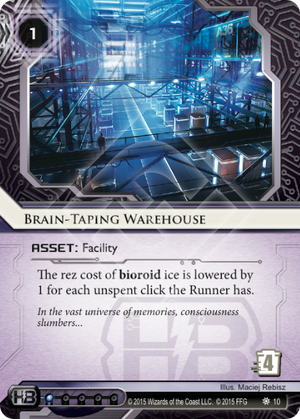 Cee: Are those tanks holding actual brains?
Cee: Are those tanks holding actual brains?
Ess: So, back in the Chronos Protocol days, we were told that “[Brain-taping] normally requires a recipient brain in a tabula rasa state to which mature brains cannot be returned”. While this suggests that brain taping refers to the process of loading bioroids with existing tapes, they would also need to load the tapes with brain images somehow, and it’s unclear to me which exactly is taping.
Cee: Actually, I’ve got something for you there! The insert for Creation and Control, while describing a new model bioroid, tells us that “The brain imaging alone cost about the same as a year’s supply of helium-3”. There’s no way that can be the cost of loading an individual bioroid with their brain, but it makes sense as the cost for imaging one brain, to be shared among an entire line of bioroids.
Ess: So imaging is the process of ripping people’s brains from them, while taping is loading that data onto blank hardware. Shame, I quite liked the oh-so-sinister image of either live or freshly dead humans being carted in, assembly line style, their brains to be ripped away from them, then heavily modified and run under corporate control…
Cee: But as a brain taping warehouse, it’s Haas’ version of Jinteki’s Braintrust; they just go through the less messy intermediary of data instead. But why would it be cheaper to boot your bioroid ice based on how many clicks—time in the day, mental capacity, whatever— the runner has left? Are you using the runner’s brain as additional compute power…?
Ess: Not the foggiest. The flavour text is no help, though I do like how it sounds like internal ad copy. In the vast universe of memories, consciousness slumbers. Warehouse 309’s brain taping output is up 26%!
Cee: Yea, none of the possible interpretations here really make all that much sense to me. Unless we’re using the number of clicks the runner has left as a proxy for some other quantity, but then why would it be impacted by the Runner taking an All-Nighter? Like Clot, this card needed to justify itself more. C+.
Ess: D+ from me. While I love the feel they’re going for here, I can’t ratify what is clearly the mechanics team bashing headlong into the lore team and coming away with a compromise neither are quite happy with.
NEXT Gold
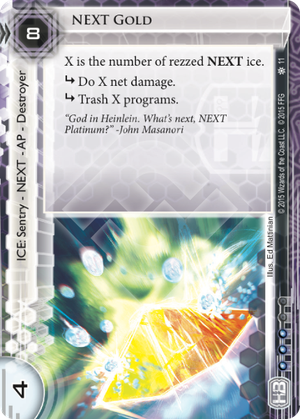 Ess: sigh.
Ess: sigh.
Cee: grin
Ess: What even are the NEXT Ice, Cee? We’ve seen Ice be lots and lots of things, from static to samurais to snakes. But the NEXT are just variously coloured pentagons! NEXT Gold is the sentry, so it’s the pointy one!
Cee: I have no idea, but I love the ambiguity and the space for speculation. Especially with this flavour text! Clearly the rest of the Android universe are just as confused as we are. And I know “God in Heinlein” is probably just an expression, but it’s giving me ideas—the NEXT feel like they’re meant to be ambiguous, the kind of deliberate ambiguity that Judaism classically ascribes to the upper orders of angels. NEXT as in next evolution? What exactly are they trying to make here?
Ess: Susanoo-no-Mikoto has given us some commentary on cybergods before; Jinteki seems to have shackled that particular naturally emergent digital entity to their own purposes. But if what you’re saying pans out, these are designed divinities.
Cee: Why not? Geometric purity. Mathematical shapes. The software that we may only glimpse by the shadows it casts on the world. Look at how the NEXT facility is built, even; clean lines, regular polygons, symmetry everywhere.
Ess: Platonic gods! Very, very tower of babel, reaching for what we may not know with the tools we know far too well. That’s… a bold interpretation, but it’d be a bold mission statement.
Cee: Platinum, then, will be as close as they get to actually engineering the divine.
Ess: shiver. Okay, C+ for the ice itself, A+ for your interpretation. Let’s see if it actually pans out!
Jinteki Biotech: Life Imagined
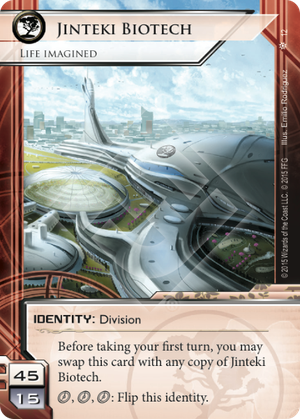
 Cee: Way to nail the feel of the Valley, FFG. The Tank, Greenhouse, and Brewery—such great names to give facilities that fit right into the collegiate air. The Tank! “We’re having our team meeting in The Tank today.” I imagine you would have to learn how to pronounce italics.
Cee: Way to nail the feel of the Valley, FFG. The Tank, Greenhouse, and Brewery—such great names to give facilities that fit right into the collegiate air. The Tank! “We’re having our team meeting in The Tank today.” I imagine you would have to learn how to pronounce italics.
Ess: Jinteki Biotech terrifies me. It’s so very Google, isn’t it? They nab the best and the brightest straight out of college, while they’re still young and idealistic, and put them to work at creepy, world-changing, terrifying stuff. You really get the sense that Biotech positions the work as fun and challenging, and that thinking about ethical consequences would only slow you down from becoming the greatest genengineer you could be.
Cee: The flip ability probably just represents how diverse a facility like Google is; while you can count on running one Jinteki commercial server to feel basically like running on another, at least while they’re enforcing the company line of Personal Evolution, you will never know quite what Biotech is up to.
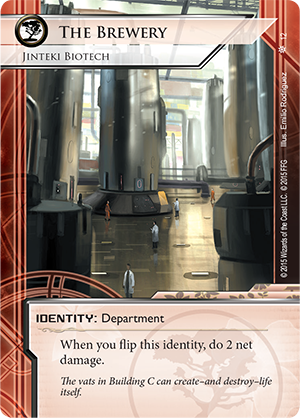
 Ess: The Brewery. The Brewery. Such a flippant, irreverent name for cloning vats; you can just tell it was named by the new grad employees at one stage. And it takes a special kind of chutzpah to name your genetic experimentation lab The Greenhouse.
Ess: The Brewery. The Brewery. Such a flippant, irreverent name for cloning vats; you can just tell it was named by the new grad employees at one stage. And it takes a special kind of chutzpah to name your genetic experimentation lab The Greenhouse.
Cee: Easy A. Such an easy A.
Ess: A all the way.
Genetic Resequencing
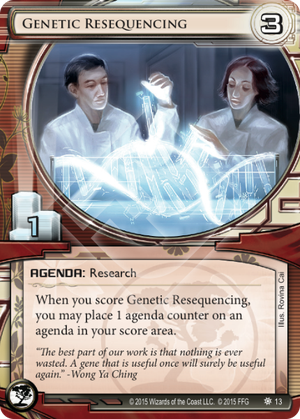 Cee: More genetics! The genetics suite are, of course, Jinteki products—as we see on Chronotype’s art. Way to equip your enemies, guys.
Cee: More genetics! The genetics suite are, of course, Jinteki products—as we see on Chronotype’s art. Way to equip your enemies, guys.
Ess: You put the Nisei line into production, and then those boffins at Biotech start clamouring about how they could make it work better and cleaner if you just let them have one more crack at it.
Cee: Art is solid, too. Though I’m not sure genetic scientists would choose a giant holographic image of the DNA sequence in question to do actual work on.
Ess: Genes have on the order of thousands or hundreds of thousands of base pairs, yeah. Not much else to say on this card; it’s a clear agenda as agendas go. B?
Cee: B-. And hey, we got to use the word “boffins”!
Cortex Lock
E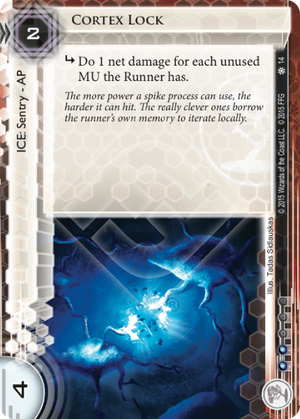 ss: It’s a fork bomb!
ss: It’s a fork bomb!
Cee: …you’re not going to explain that, are you. A fork bomb, dear readers, is a process that continually splits off more and more copies of itself, such as to take over all of your computer’s resources and lock it down. Usually, the first resource to go is memory.
Ess: And this fork bomb clearly has an additional payload of STAB THE RUNNER IN THE BRAIN.
Cee: Exploding neurons! As depicted in some frankly excellent art by Mr. Sidlauskas. A little research indicates that this appears to be his first commission for Netrunner, but I hope we see more from him!
Ess: Cortex Lock is a great example of how flavour text can work as the glue between the mechanics and story. It does the workmanlike job of justifying this effect in the game, while still being a joy to read in its own right. This is why the Regions tend to have flavour text more often than not, too; their effects do tend to need this sort of justification.
Cee: …Valley Grid is next, isn’t it.
Ess: I’m going to ask you to not jump ahead while remaining oblivious of the hypocrisy. A for Cortex Lock?
Cee: Yep!
Valley Grid
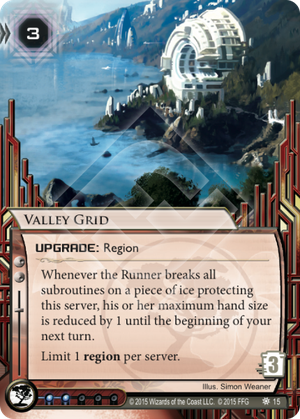 Cee:
Cee:
Ess:
Cee: I got nothin’.
Ess: Why would interacting with ICE in a specific geographical area cause you to be mentally exhausted afterward? Hand size and cards in hand are a very loose flavour-to-mechanics correspondence anyway, but this card really seems to be stretching it.
Cee: I’m not even sure what the art is. Is it a turbine? Is it a building? Art for the regions so far has always been of the city itself.
Ess: Wait. are those ships on the sea? Those are skyscrapers at the foot of this thing!
Cee: I dunno, I’m not convinced. I mean, look at the buildings in the background that are further away. My sense of scale is really distorted here. This thing could be reasonably sized or, like, can-see-from-space huge. What the hell is it?
Ess: Could it be the world’s largest supercomputer? It’s certainly shiny enough. Maybe the Valley Grid is literally run on about two or three vast research supercomputers, and it’s hotpatching your software for the different architecture that’s causing the brain drain?
Cee: Maybe? I’m not sure I can give this a score for flavour when I’m not sure there is flavour.
Ess: Fair. There’s not that much we can say about a card we’re so confused on. It’s worth noting that it’s only the third out of twelve regions to not have any flavour text at all—and one of the others is Satellite Grid, which doesn’t exactly need flavour text!
Bandwidth
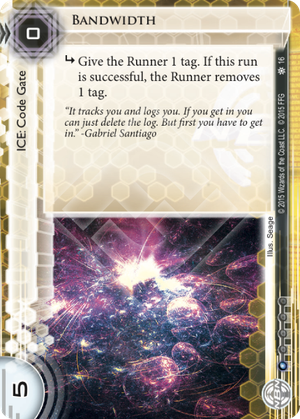 Ess: It’s a reference to Uplink! Uplink was a classic computer game, the “best simulation of Hollywood Hacking ever created”. It pretty much pioneered the narratively elegant concept of cleaning your tracks by deleting the logs once you’ve gotten in. It’s nice to see a classic of the genre getting its shout out!
Ess: It’s a reference to Uplink! Uplink was a classic computer game, the “best simulation of Hollywood Hacking ever created”. It pretty much pioneered the narratively elegant concept of cleaning your tracks by deleting the logs once you’ve gotten in. It’s nice to see a classic of the genre getting its shout out!
Cee: The card is very clean mechanically, and the flavour text is solid to match, but… what does this effect have to do with Bandwidth? It’s as if they took the art and name of a different card and slapped on this flavour text and effect.
Ess: Which is entirely plausibly what they actually did. It happens, sometimes, that mechanics and lore can’t quite agree on what to do, and they really need this effect pushed through… but yeah, it leaves the card a bit schizophrenic.
Cee: Unfortunate. I want to score it highly, but as is the card is just too inconsistent with itself. C.
Ess: I can’t give the Uplink reference below a B, but yeah, it is disappointing.
Predictive Algorithm
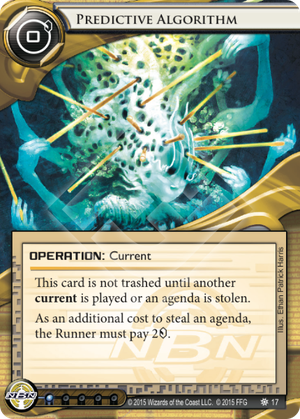 Ess: The first path I went down trying to make sense of this card was with other agendas that cost credits to steal—NAPD Contract, Fetal AI, and Utopia Fragment sorta. But then I remembered that Red Herrings was a card.
Ess: The first path I went down trying to make sense of this card was with other agendas that cost credits to steal—NAPD Contract, Fetal AI, and Utopia Fragment sorta. But then I remembered that Red Herrings was a card.
Cee: How is Herrings meant to work, anyway?
Ess: I’m glad you asked! NBN clearly has access to vast collections of junk information, in the form of the marketing and psychographic profiles of every consumer on the planet.
Cee: And off it!
Cee: Oh, just so you know: space lasers are actually really hard to come by.
Ess: So when they bury real data in vast amounts of junk noise, the Runner probably has to buy up a huge number of compute cycles to sift through it in the limited amount of time they have. The Predictive Algorithm operates on the same principle; if they have some idea of where you’ll look first, they can simply put the data under the key you’ll look for last.
Cee: The “predictive algorithm” here is clearly some sort of machine learning, seeded with, what, records of past intrusions that NBN has been carefully keeping? Colour me perplexed on the art, though.
Ess: Is it… a visual representation of a neural network feeding knowledge into its head?
Cee: It’s unclear, is what it is. Your interpretation of how it works makes sense, but I feel like the card could have done more to explain itself to us. I’m going to give it a very confused C-.
Ess: I’m unreasonably fond of how even in a world with actual psychics, NBN’s comparative advantage is still in throwing vast amounts of data into a predictive algorithm. As NBN reflecting the Nisei line through a funhouse mirror, I can give it a B.
Capital Investors
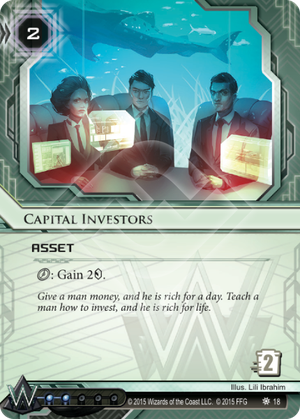 Cee: It’s an actual shark tank! That’s far more amusing than it should be. The show isn’t even really any good, but I love the direct reference. Is this also the same room that aggressive negotiations happen in? There’s gotta be some blood on the floor just to add that little bit of extra persuasion…
Cee: It’s an actual shark tank! That’s far more amusing than it should be. The show isn’t even really any good, but I love the direct reference. Is this also the same room that aggressive negotiations happen in? There’s gotta be some blood on the floor just to add that little bit of extra persuasion…
Ess: What intrigues me is how the risky, fraught, and crazy business of investing is massaged into the predictable, boring mechanic of spend time, get money. It really speaks to how different these things look on the other end, when you have vast amounts of money to diversify and hedge on.
Cee: And when you have very very good capital investors. Hedge funds are also, in Netrunner, an entirely reliable, completely predictable method of generating funds.
Ess: That reminds me—The Netrunner Project made the very cogent point that in the Android universe, “the most iconic way to make a quick buck, after all these years, in a world with mining on the moon and clones in the household, is still, as ever, running a fucking Hedge Fund.” Capital Investors, then, is the other half of that statement, given its potential to be as iconic as Opus.
Cee: You don’t need to set up a shell corporation, you don’t need to take out private contracts, you don’t even need to sell PADs to shmucks who don’t need another one. You can just take your money, and hand it to your investors.
Ess: Easy A?
Cee: Easy A.
Negotiator
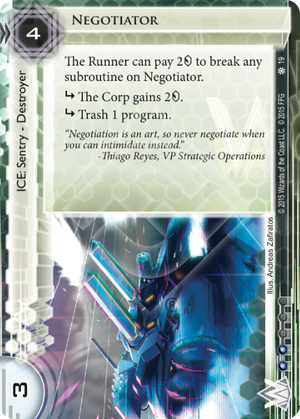 Cee: I really really like everything about this card. It’s so incredibly Weyland. “Never negotiate when you can intimidate instead”, so they built a Negotiator that doesn’t negotiate!
Cee: I really really like everything about this card. It’s so incredibly Weyland. “Never negotiate when you can intimidate instead”, so they built a Negotiator that doesn’t negotiate!
Ess: Who would want to negotiate with that? Please sir, is it only my money you would like? Please sir, very good sir.
Cee: Your money or your programs, punk.
Ess: I’d like to meet this Thiago Reyes. He’s clearly the guy who wrangled that “Gain 2 credits” subroutine onto Archer, as well, because no big mean angry ICE is complete without adding that final insult to injury.
Cee: Weyland at heart. Vicious, angry, but always, always making money. This one gets another A from me.
Ess: I’m almost tempted to give it an A+.
Tech Startup
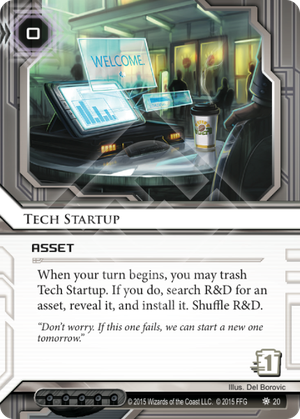 Ess: The heart and soul of the Valley, startups.
Ess: The heart and soul of the Valley, startups.
Cee: I love how we’re just using and abusing the poor things. It’s not even a corporate buyout, you just straight up burn them for their good ideas and cut away the rest.
Ess: And it’s not even the kids’ own ideas you’re burning them for; all tech startups are indistinguishable. The corporation just says wouldn’t it be great if we could something something, waits for them to break through the key blockage, and then steals it and goodbye!
Cee: A cosier interpretation might be that the startup is maturing into the asset in question, but that just seems implausible in so many cases. A tech startup developing into Melange Mining Corp? Into a Dedicated Response Team? Into Elizabeth Mills?
Ess: Execs are still a bit weird, though. I guess you’re enticing them back to work on the front lines with the promise of a new toy? Quite literally, in Jackson’s case.
Cee: The whole card is very well designed—with one exception. I hate to say it, but, again, the art lets it down. It’s not very startuppy. When you think of startups you think of sleep deprived programmers who have forgotten how to speak English and whose blood is probably almost entirely caffeine, not clean and schmick office spaces with fancy displays on the walls.
Ess: They do have the coffee, though.
Cee:
Ess: A startup is a device for turning coffee into code, my CEO always said!
Cee: I want to see at least eight cups before I’ll give them a pass on that one. Coffee pod machine optional but highly encouraged.
Ess: Maybe that cup is actually directly linked to some vast underground coffee dispensing machine, via desk pneumatics!
Cee:
Ess: Um. If there’s any card that should rez for zero creds, it’s this one?
Cee: You see this face? This is my disapproving face. I can give it a B, and no higher.
Ess: A+ from me. It would have been perfect with Interns-style art, but it’s just too snarky, too cynical, and too elegant for me to give it anything else.
Cee: And that’s a wrap! How did you like your trip to Biotech Valley, Ess?
Ess: I really enjoyed it. Honestly, I think FFG’s been going from strength to strength, in designing our view to the Android universe through these tiny 65x90mm windows, and I’m super excited for our trip across the rest of SanSan over the coming months.
Cee: There are certainly some very strong pieces here, but there’s also plenty of room for improvement. I’m just hoping I get to give fewer Cs and Ds.
Ess: Yeah, it’s always disappointing when a card doesn’t work out. I would have liked to know more about how HB sees its brain taping warehouses, or what it means for the Runner to clot up the Corp, and these corners of the world are now much harder to explain. Via the game, anyway.
Ess: But I do love how after the Genesis cycle and core set gave us the “base” information about the world, FFG’s just in full on let’s-explore-the-world mode now. They tried for it in the Spin and Lunar cycles, and I really think they’re doing their best yet here in SanSan. A large part of it is this constant, underlying sense of place to every card in this set, of a Valley we recognise but has yet grown far beyond what we know.
Cee: Even the inserts in Lunar went a long way to giving us more context for the world, and many of the cards were neatly tied in. We Australians haven’t had a chance to see The Valley’s insert yet, but the cards themselves are certainly a promising start. I hope they keep it up!
Ess: Until next time, then. It’s been a pleasure.
Cee: This is Ess and Cee, signing off.




